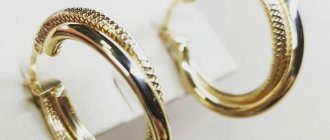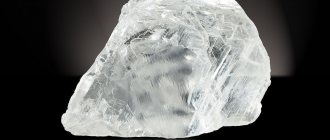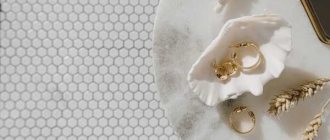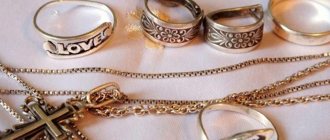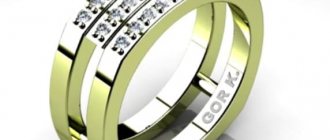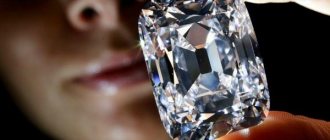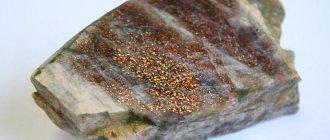Diamond, one of the most sought-after stones in jewelry production, has been subjected to all sorts of cuts over many centuries of use, the most luxurious settings have been selected for it, and combinations with other precious stones have been tried.
It would seem that there can be no talk of any innovative technologies in the field of diamond processing and framing.
However, 7 years ago a dancing diamond appeared - a brilliant invention that became a real breakthrough in the art of making jewelry from shining crystals.
What is a dancing diamond?
A “dancing” diamond is a gemstone that has been specially cut to give it a cross-shaped shine and is set in a piece in a special way that allows it to balance on two supports, moving with the breeze or a barely noticeable sigh.
Why is it called that?
Since 2012, the term “dancing diamond” has been used to designate a new type of jewelry in which the stones are in constant dynamics due to the special design of the frames.
In these products, the dazzling shine of diamonds, endowed with the ability to repeatedly refract rays of light passing through them, is enhanced by the non-stop vibration of crystals that react to even the slightest body movement.
It is this dazzling light extravaganza that is called “dance”.
History of creation
For several centuries, diamonds in jewelry, attached in a hard or semi-hard way, showed their natural properties either in bright light or with the help of active movements of their owner.
Japanese jeweler Hidetaka Dobashi, who owns his own jewelry company founded in 1980, set out to improve jewelry in such a way that the optical effects inherent in diamonds were maximized, and everyone present could fully enjoy the beauty of the shining crystals.
After many years of studying gemology, Hidetaka Dobashi invented and patented an original cutting method in 1999, in which the 46 facets of a diamond emit a bright cross-shaped glow.
In 2010, the master, who thoroughly studied all the intricacies of light refraction in diamonds and other transparent stones (his area of specialization was previously rubies and sapphires), began to develop a special mount, thanks to which the crystals could “dance”, demonstrating a unique play of light.
The intense work, during which several dozen diamonds were irreparably damaged (the fastening, which seemed very simple, did not want to work properly), continued for two years.
Hidetaka Dobashi presented the first batch of jewelry with dancing diamonds (this was only a small part of the collection, consisting of a dozen pendants and earrings) to the public at a jewelry exhibition in Hong Kong in June 2012.
The constantly moving and seemingly living stones, scattering whole sheaves of dazzling sparks, oddly enough, did not make much of an impression on the visitors of the exhibition that time.
However, three months later, at the same exhibition in Hong Kong, Hidetaka Dobashi presented the “Dancing Stones” collection, consisting of 150 products and having a stunning success. Earrings, pendants, pendants and rings with floating crystals were appreciated.
The author of the original products received many orders and entered into dozens of agreements with investors who wanted to cooperate with his jewelry company.
A year after the landmark exhibition, Hidetaka Dobashi received an international patent for the frame he invented, valid in the United States of America, Europe, India and China.
Interest in jewelry with dancing crystals has not faded to this day. The jewelry company owned by Mr. Dobashi issues patent licenses to any companies that create jewelry from loose stones.
Construction device
In order to understand the essence of the invention of master Hidetaka Dobashi, you need to know about two traditional methods of fixing stones in jewelry: hard and semi-rigid:
- Rigidly fixed crystals can only move with the product itself. For example, in order for a diamond inserted into a ring to sparkle with all its facets, its owner must move her hand.
- In products with semi-rigid fastening (as a rule, these are earrings and pendants), the frame of the stones is fixed at one specific point. As a result, when the owner of the jewelry moves, the stones begin to make oscillatory movements, which soon die out.
The invention of the Japanese master consisted of a fundamentally new method of fixing crystals, in which a stone attached to two movable supports even reacts to the heartbeat of its owner.
This unique effect is especially noticeable when wearing dancing crystal pendants, which are known to be worn on the chest.
The setting of stones, developed by a Japanese jeweler, is reliable and amazingly simple. The dancing diamonds in this type of jewelry are placed in a special setting, the left and right sides of which are spot soldered to the back of the jewelry.
Thanks to a precisely adjusted balance, the dancing crystal, in response to even a barely noticeable movement (including breathing) of the owner of the product, begins to perform pendulum-like swaying movements, which, contributing to the appearance of a large number of glares, increase the number of refracted rays.
As a result, a person admiring the play of light in a crystal has the feeling that it is shining continuously.
To ensure that the dancing diamond does not touch the clothes or body of its owner, the reverse side of the product is covered with a special element that helps ensure that the spectacular “dance” of the crystal lasts as long as possible.
The frame of the first products with dancing crystals (which, by the way, can be not only cut diamonds, but also other transparent minerals) was made of yellow gold. Nowadays, any noble metals are used for its manufacture, including platinum and silver.
In conclusion, I would like to note that the setting of exclusive jewelry in no way affects the quality of the crystals it holds (it is worth recalling that well-cut, high-quality stones are used as dancers: only in this case the play of light will emphasize their purity).
If desired, they can be removed from the frame at any time and used to make another piece of jewelry.
Jewelry sensation
Admiration came a few months later at another exhibition, in which the entire collection of jewelry with dancing diamonds participated. Pendants, pendants, rings and earrings performed their lively dance in such a way that they literally captivated everyone.
Their movement was so smooth that many wanted to immediately purchase earrings with floating diamonds. Many investors immediately agreed to work with Dobashi. He received a patent for his invention.
Before this sensational discovery, jewelers used static methods to set gemstones. With rigid or semi-rigid fixation, cut diamonds could not move; they could not be called dancing. They only shone when the owner made a sudden movement or when a bright light was directed at them.
Now everything has changed. Jewelry with floating diamonds can constantly play with light.
Properties of dancing crystals
People have known since time immemorial that diamonds are endowed with many healing properties. Many handwritten treatises are devoted to this topic.
According to gemologists, with the help of dancing crystals one can treat mental disorders and diseases of the nervous system, and also use them in the fight against:
- drug addiction;
- alcoholism;
- insomnia;
- sclerosis;
- depressive states;
- all kinds of stress and phobias.
In addition, lithotherapists use dancing diamonds for:
- treatment of skin diseases;
- improving the functioning of the digestive organs;
- treatment of diseases of the musculoskeletal system and upper respiratory tract;
- strengthening the immune system.
It should be taken into account that when treating serious illnesses, the healing power of dancing diamonds should be used as part of complex therapy, which prescribes the mandatory use of medications prescribed by a qualified specialist.
However, the very fact of presenting jewelry with a dancing diamond can not only improve the mood of any representative of the fair sex, but also make her feel happier.
Dancing (sometimes called floating) diamonds, virtually free of flaws, are suitable for women of any age. You will have to get used to their non-stop flickering.
If the expressive play of continuously dancing crystals causes irritation, it is better to refuse to purchase such jewelry.
History of origin
Since 1980, the famous jeweler Dobashi has been actively selling his own jewelry. During that period, he opened a well-known company called Crossfor Co, where he sold products. One of his developments was a ring with a dancing diamond, but before that his achievements included a huge number of various developments. First of all, all his activities were aimed at studying the unique properties of precious stones.
The cut that the jeweler came up with was completely new and had never been used before. Its peculiarity was that it made it possible to obtain a so-called cross-shaped glow. It was achieved due to the special arrangement of 46 faces of the mineral. Therefore, a pendant with a dancing diamond and other jewelry are now quite original.
In 2012, a large-scale jewelry exhibition was held in Hong Kong, where a Japanese jeweler was able to present his first samples of dancing stones. But, as it turned out, they did not particularly impress those who saw them. Therefore, Dobashi took up the task of improving it, in the process of which he ruined more than one hundred stones.
In fact, success came to the jeweler much later. Literally a few months later, the next exhibition took place, where purely dancing products were presented. Of the 145 samples, it was Dobashi’s collection that created an incredible sensation.
Today, the boundaries have been significantly expanded, and now such dancing jewelry is made by many manufacturers who deserve only positive reviews. Chopard is rightfully considered one of the largest brands. Among domestic manufacturers, the company located in Bronnitsy, called “Bronnitsky Jeweler,” deserves special attention. When making a dancing diamond, the Bronnitsky jeweler uses only the best technologies that were proposed by Dobashi.
Prices
In the catalog of a network of jewelry stores, prices for jewelry from the “Dancing Diamond Air” collection are as follows:
- ring – from 58,000 rubles;
- suspension – from 34,000 rubles;
- bracelet – from 160,000 rubles;
- earrings – from RUB 73,000;
- necklace – from RUB 39,000;
- studs – from 76,000 rub.
The cost of the products depends on the number of stones used, their dimensions, weight and what metal is used to make the frame (white, yellow or red gold).
The cost of jewelry made to order is calculated individually.
When purchasing jewelry, each crystal must be examined with a magnifying glass to make sure there are no small cracks, chips, scratches or unwanted inclusions.
Where else to buy?
Citizens of the Russian Federation can purchase products with dancing diamonds:
- In a chain of retail stores owned by .
- In one of the 140 jewelry stores of the “Lines of Love” network, located in sixty cities of Russia, which are official representatives of jewelry (Kostroma).
- In the online store "Moscow Jewelry Factory".
- In branded sections (they are available in almost all major jewelry stores) or in Sokolov flagship stores. This brand also has an official online store.
- In the Adamas chain of jewelry stores.
- B (there are more than 350 of them in Russia).
The technology for making jewelry with dancing crystals is not a secret development and is widely used by jewelers all over the world. Similar products from the famous Italian brand Roberto Bravo are very popular among Hollywood movie stars.
In Russia, the production of jewelry of this type is carried out by:
- Bronnitsky Jewelry Factory.
- Jewelry, located in the Kostroma region (its products are known on the market under the Sokolov brand).
- Muz (Moscow jewelry factory).
Is it worth buying?
The answer to this question should be based on personal preference:
- Jewelry with dancing diamonds, mesmerizing with the beauty of their enchanting radiance, is ideal for extravagant ladies who love to be the center of everyone's attention.
- Modest girls who prefer stones that emit a muted soft glow are better off opting for classic pieces.
Customers' opinions
A dancing diamond, according to many buyers, is a very unusual piece of jewelry. If you want to surprise a loved one with something, then this is the most suitable option. Of course, the prices for such jewelry are higher than usual, but the quality of the stones used is worth it. Some people find the constant rocking of the pebble annoying and may even worry that it will slip out, but this is not the case.
The fastenings are made inside the frame, and correctly calculated balancing does not allow the stone to fall out.
Those who like the exoticism of an unusual design note its attractive properties of “sprinkling” sparks around itself and shimmering with all the colors of the rainbow at the slightest vibration. In any case, such a gift is unlikely to leave anyone indifferent.
How to wear?
- Jewelry with dancing diamonds (especially earrings and pendants), mesmerizing with the iridescent shimmer of crystals exclusively in evening light, is appropriate only in combination with expensive evening dresses. They are completely unsuitable for creating everyday images, since in everyday life and in daylight, stones that have lost their dazzling shine can be mistaken for ordinary jewelry.
- Accessories with dancing crystals can be worn on a romantic date, private party, social event or business dinner.
- Stones that are in constant motion look best when set in yellow or white gold.
- Any item with dancing crystals is considered to be an ideal engagement gift.
About the cost of products
Let's say a few words about the price. So, a gold ring with a dancing diamond can be bought for 70 thousand rubles. Moreover, it will be made of 585 white precious metal. The central floating stone has 57 facets and weighs 0.167 carats. The frame uses 18 small stones, 0.072 carats each. The purity of all minerals is rated 5, which indicates high quality. A decoration with similar characteristics, but without small stones in the frame, will cost 56 thousand rubles.
Earrings with diamonds weighing 0.337 carats can also be purchased for 70 thousand rubles. 585 red gold is used here. But jewelry made of white gold with slightly larger stones – 0.36 carats – has approximately the same price. Round cuts are used throughout, and the stones themselves are mounted on two supports, allowing them to remain dancing.
The cost of the products includes the cost of the precious metal, so it is logical that, weighing much less than rings or earrings, the pendants will cost less. For example, a pendant made of white gold with a floating diamond has a price of about 35 thousand rubles, although the stone inserted into it is similar in size and other characteristics to the crystal from the ring described above.
Reviews
Reviews from customers who own jewelry with dancing stones are full of rave reviews.
The advantages of these products, in their opinion, are:
- The ability to emit continuous flickering as a result of imperceptible impulses (for example, during breathing and even rapid heartbeat) emanating from their owners. As a result, the owners of exquisite jewelry, emitting cascades of dazzling flashes, find themselves in the center of admiring attention from others.
- The highest quality (manifested in the impeccable coloring and ideal purity of the stones) and the impeccable cut of the diamonds used to make jewelry.
- In the extraordinary reliability of fastening the stones, “dancing” in an almost imperceptible frame.
The number of people who do not share the enthusiasm of fans of a fashionable novelty is very small. From their point of view, continuously twitching crystals emitting a trembling glow cause nothing but irritation.
Famous collection
Earrings with diamonds are especially expressive if the stones in them are movable, that is, dancing. They are also often inserted into pendants or pendants. For example, specialists from some companies decorate the watches they produce with playing crystals.
A ring with a floating diamond or ring is less common, but they still attract attention. There is a collection that includes magnificent rings, where the stone is fixed on two movable supports. Its edges, when swayed, create a real rainbow. 585 gold (yellow, red, white) is used for framing.
Collections can contain not only classic earrings with diamonds, but also chandelier earrings. The illusion of flickering lights intensifies when you turn your head. When walking uniformly, the rays directed from the stone also move smoothly.
Dancing diamonds set into pendants and pendants are framed in elegant gold and platinum frames. They look like traditional hearts, blobs, or even space designs.
Other Dancing Diamond Settings
The term “dancing diamond” can only be used in relation to products made in accordance with the technology developed by the master Hidetaka Dobashi, however, recently, under the guise of “dancing”, sellers often offer jewelry (earrings and pendants) in which stones are rigidly attached to movable suspension fixed separately.
This long-known and widespread method has nothing to do with dancing crystals.
Not long ago, jewelers began to practice the technique of setting dancing diamonds without using any settings.
Having made a through hole in the crystal using a laser, they insert the thinnest platinum wire into it, thanks to which the diamond, like a bead hanging on a fishing line, acquires the ability to rotate and flicker, reflecting the light falling on it.
This method also does not make the stone dance, since partial contact with the wearer’s clothing and body deprives it of the effect of continuous radiance.
Despite its external effectiveness, this technique, associated with irreversible damage and - in connection with this - a reduction in the cost of the dancing crystal, has not become widespread.
What is the invention
In order to understand how the innovation invented by Mr. Dobashi is expressed, let’s first consider how traditional gems are attached.
There are only two ways:
- Rigid fixation of the stone in the decoration. With this method, the stone can only move together with the entire decoration. For example, a diamond ring.
- The stone is fixed at one point, “suspended”. This mount is used for pendants and earrings. If the jewelry sways when the owner moves, then the stone sways, but such vibrations quickly die out.
Hidetaka Dobashi's invention is aimed precisely at ensuring that the slightest movement - even a sigh - causes the diamond to vibrate, although the jewelry itself is not particularly affected.
He managed to achieve this through an unusual fastening design - the stone in it is limited to two points of contact. Due to this, he literally comes to life, plays, “dances.”
Photo of dancing diamonds
The Secret of the Stone Dance
The Japanese master, creating a dancing diamond, used several basic principles:
- the gemstone in the product should not touch the owner’s body or clothing;
- fastening on two supports allows the stone to oscillate like a pendulum with any movement;
- Only diamonds of the highest quality are used so that the play of rays, thanks to the cut, enhances their purity.
In order to fulfill the first requirement, there is always a piece of jewelry between the stone and the body or clothing of the owner. The second feature is that the two clamps used provide the diamond with the ability to react even to the heartbeat. This effect is very noticeable in the case of dancing diamonds in pendants located on the chest.
It happens that a gem is attached to a piece of jewelry without using a setting. To do this, using a laser beam, a through hole is made in the crystal, into which a thin platinum wire is inserted. A diamond is like a bead that is movable, has the ability to rotate and shimmers, reflecting light. But this is not considered a very good method, since, in fact, the stone will be damaged by such a cut.
Types of stone cuts
In order for the mined diamond to shine with all its enchanting shades, it must be processed and cut. Jewelry craftsmen use different types of cutting of precious stones. Among them, the most common are the following:
- Improved. With this cut you can achieve fancy diamond shapes. Such stones shimmer magnificently when light hits them. The main shapes of the improved cut are: trillion, marquise, heart, teardrop, or pear, oval.
The disadvantages of this cut are the fragility of stones compared to round cuts. Also, if there are flaws in the stone, they will be visible.
- Round. This cut is the most popular and in demand. The round cut is most often found in dancing diamond jewelry. The number of edges of this cut is 57. This is the number that helps achieve the greatest play of light when mounted in a frame.
It is believed that diamonds cut in this way are the most durable. The only significant drawback of this cut is the large proportion of stone that is lost during cutting.Jewelry with round diamonds is some of the most expensive in the world. There are two types of round cut. Type A cut is ideal in its structure, since all faceted areas are proportional to each other. Type B cut is asymmetrical; sections of the stone can be stretched both in height and in diameter.
- Stepped.
This cut shape helps produce a rectangular or square shaped diamond. Most diamonds of this cut have sharp corners that are ground down. This cut helps preserve the weight of the gemstone as much as possible, thereby increasing the number of carats. Step cut diamond shapes include rhombus, baguette, trapezoid, kite, emerald, asscher. However, with this cut, the stones lose a little of their shine, and due to their small size, flaws become visible in them. - Mixed.
Combines advanced and step cuts. It comes in the following forms: princess, radiant, baryon, flanders. Such diamonds are quite vulnerable, they need to be carried carefully so as not to break or scratch the corners. - Antique. One of the most ancient types of cutting, which includes the rose shape, European and antique. Diamonds of this cut are quite massive and have a lot of weight.


